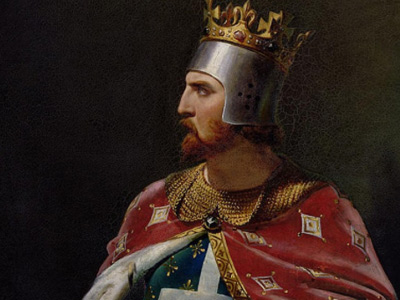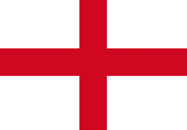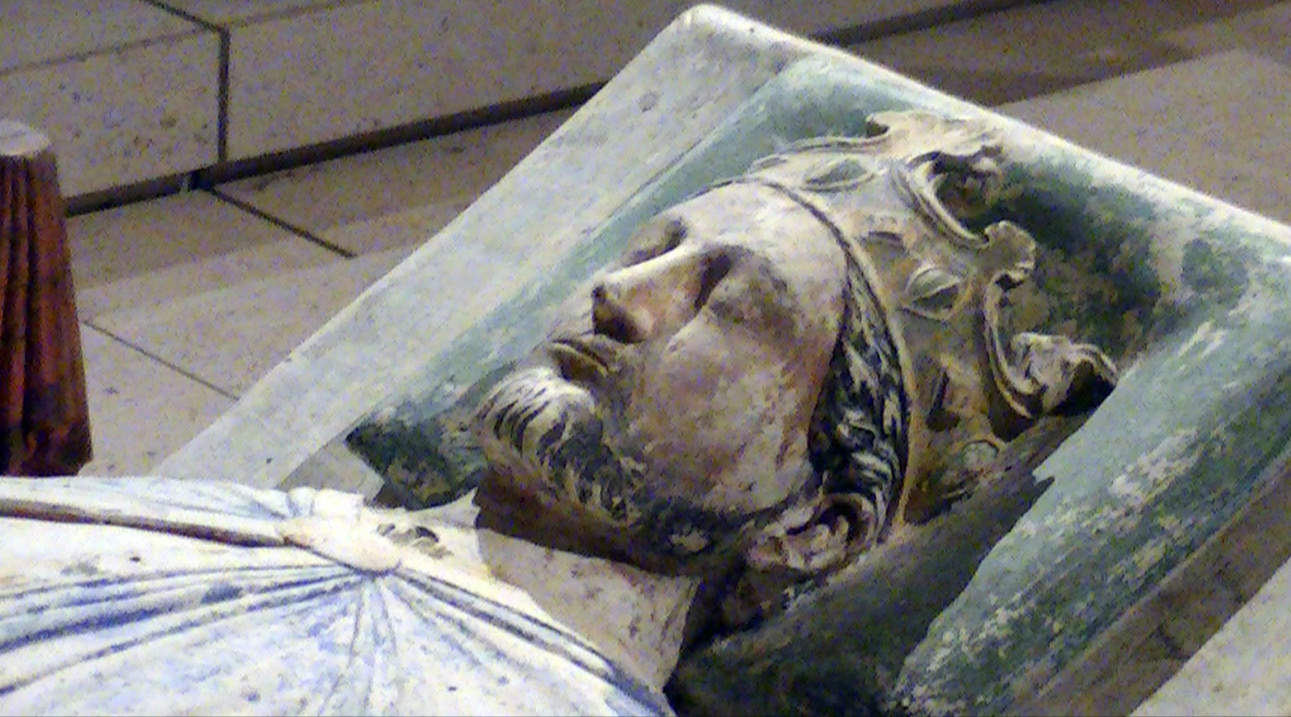Richard I of England (1157-1199)
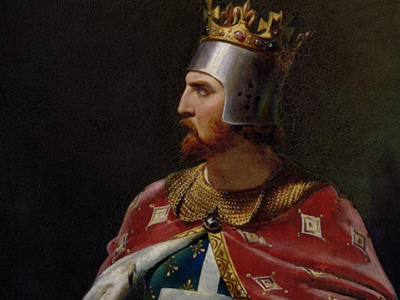
Final Years of Henry II's Reign
After the conclusion of the war, the process of pacifying the provinces that had rebelled against Henry II began. The King travelled to Anjou for this purpose, and Geoffrey dealt with Brittany. In January 1175 Richard was dispatched to Aquitaine to punish the barons who had fought for him. The historian John Gillingham notes that the chronicle of Roger of Howden is the main source for Richard's activities in this period. According to the chronicle, most of the castles belonging to rebels were to be returned to the state they were in 15 days before the outbreak of war, while others were to be razed. Given that by this time it was common for castles to be built in stone, and that many barons had expanded or refortified their castles, this was not an easy task. Roger of Howden records the two-month siege of Castillon-sur-Agen; while the castle was "notoriously strong", Richard's siege engines battered the defenders into submission. On this campaign Richard acquired the name "the Lion" or "the Lionheart" due to his noble, brave and fierce leadership. He is referred to as "this our lion" (hic leo noster) as early as 1187 in the Topographia Hibernica of Giraldus Cambrensis, while the byname "lionheart" (le quor de lion) is first recorded in Ambroise's L'Estoire de la Guerre Sainte in the context of the Accon campaign of 1191.
Henry seemed unwilling to entrust any of his sons with resources that could be used against him. It was suspected that Henry had appropriated Princess Alys, Richard's betrothed, the daughter of Louis VII of France The Kingdom of France is the historiographical name or umbrella term given to various political entities of France in the medieval and early modern period. It was one of the most powerful states in Europe since the High Middle Ages. It was also an early colonial power, with possessions around the world. Colonial conflicts with Great Britain led to the loss of much of its North American holdings by 1763. The Kingdom of France adopted a written constitution in 1791, but the Kingdom was abolished a year later and replaced with the First French Republic. by his second wife, as his mistress. This made a marriage between Richard and Alys technically impossible in the eyes of the Church, but Henry prevaricated: he regarded Alys's dowry, Vexin in the Île-de-France, as valuable. Richard was discouraged from renouncing Alys because she was the sister of King Philip II of France, a close ally.
The Kingdom of France is the historiographical name or umbrella term given to various political entities of France in the medieval and early modern period. It was one of the most powerful states in Europe since the High Middle Ages. It was also an early colonial power, with possessions around the world. Colonial conflicts with Great Britain led to the loss of much of its North American holdings by 1763. The Kingdom of France adopted a written constitution in 1791, but the Kingdom was abolished a year later and replaced with the First French Republic. by his second wife, as his mistress. This made a marriage between Richard and Alys technically impossible in the eyes of the Church, but Henry prevaricated: he regarded Alys's dowry, Vexin in the Île-de-France, as valuable. Richard was discouraged from renouncing Alys because she was the sister of King Philip II of France, a close ally.
After his failure to overthrow his father, Richard concentrated on putting down internal revolts by the nobles of Aquitaine, especially in the territory of Gascony. The increasing cruelty of his rule led to a major revolt there in 1179. Hoping to dethrone Richard, the rebels sought the help of his brothers Henry and Geoffrey. The turning point came in the Charente Valley in the spring of 1179. The well-defended fortress of Taillebourg seemed impregnable. The castle was surrounded by a cliff on three sides and a town on the fourth side with a three-layer wall. Richard first destroyed and looted the farms and lands surrounding the fortress, leaving its defenders no reinforcements or lines of retreat. The garrison sallied out of the castle and attacked Richard; he was able to subdue the army and then followed the defenders inside the open gates, where he easily took over the castle in two days. Richard the Lionheart's victory at Taillebourg deterred many barons from thinking of rebelling and forced them to declare their loyalty to him. It also won Richard a reputation as a skilled military commander.
In 1181–1182 Richard faced a revolt over the succession to the county of Angoulême. His opponents turned to Philip II of France for support, and the fighting spread through the Limousin and Périgord. The excessive cruelty of Richard's punitive campaigns aroused even more hostility. However, with support from his father and from the Young King, Richard the Lionheart eventually succeeded in bringing the Viscount Aimar V of Limoges and Count Elie of Périgord to terms.
After Richard had subdued his rebellious barons he again challenged his father. From 1180 to 1183 the tension between Henry and Richard grew, as King Henry commanded Richard to pay homage to Henry the Young King, but Richard refused. Finally, in 1183 Henry the Young King and Geoffrey, Duke of Brittany, invaded Aquitaine in an attempt to subdue Richard. Richard's barons joined in the fray and turned against their duke. However, Richard and his army succeeded in holding back the invading armies, and they executed any prisoners. The conflict paused briefly in June 1183 when the Young King died. With the death of Henry the Young King, Richard became the eldest surviving son and therefore heir to the English crown. King Henry demanded that Richard give up Aquitaine (which he planned to give to his youngest son John as his inheritance). Richard refused, and conflict continued between them. Henry II soon gave John permission to invade Aquitaine.
To strengthen his position, in 1187, Richard allied himself with 22-year-old Philip II, the son of Eleanor's ex-husband Louis VII by Adele of Champagne. Roger of Howden wrote:
"The King of England was struck with great astonishment, and wondered what [this alliance] could mean, and, taking precautions for the future, frequently sent messengers into France for the purpose of recalling his son Richard; who, pretending that he was peaceably inclined and ready to come to his father, made his way to Chinon, and, in spite of the person who had the custody thereof, carried off the greater part of his father's treasures, and fortified his castles in Poitou with the same, refusing to go to his father."
Overall, Howden is chiefly concerned with the politics of the relationship between Richard and King Philip. Gillingham has addressed theories suggesting that this political relationship was also sexually intimate, which he posits probably stemmed from an official record announcing that, as a symbol of unity between the two countries, the kings of England The Kingdom of England was a sovereign state on the island of Great Britain from about 927, when it emerged from various Anglo-Saxon kingdoms, until 1 May 1707, when it united with Scotland to form the Kingdom of Great Britain. The Viking invasions of the 9th century upset the balance of power between the English kingdoms, and native Anglo-Saxon life in general. The English lands were unified in the 10th century in a reconquest completed by King Æthelstan in 927. and France had slept overnight in the same bed. Gillingham has characterized this as "an accepted political act, nothing sexual about it;... a bit like a modern-day photo opportunity".
The Kingdom of England was a sovereign state on the island of Great Britain from about 927, when it emerged from various Anglo-Saxon kingdoms, until 1 May 1707, when it united with Scotland to form the Kingdom of Great Britain. The Viking invasions of the 9th century upset the balance of power between the English kingdoms, and native Anglo-Saxon life in general. The English lands were unified in the 10th century in a reconquest completed by King Æthelstan in 927. and France had slept overnight in the same bed. Gillingham has characterized this as "an accepted political act, nothing sexual about it;... a bit like a modern-day photo opportunity".
In exchange for Philip's help against his father, Richard promised to concede to him his rights to both Normandy and Anjou. Richard paid homage to Philip in November 1187. With news arriving of the Battle of Hattin, he took the cross at Tours in the company of other French nobles.
In 1188 Henry II planned to concede Aquitaine to his youngest son John. But Richard refused the thought. He felt that Aquitaine was his and that John was unfit to take over the land once belonging to his beloved mother. This refusal is what finally made Henry II bring Queen Eleanor out of prison. He sent her to Aquitaine and demanded that Richard give up his lands to his mother who would once again rule over those lands.
The following year, Richard attempted to take the throne of England for himself by joining Philip's expedition against his father. On 4 July 1189, the forces of Richard and Philip defeated Henry's army at Ballans. Henry, with John's consent, agreed to name Richard his heir apparent. Two days later Henry II died in Chinon, and Richard the Lionheart succeeded him as King of England, Duke of Normandy, and Count of Anjou. Roger of Howden claimed that Henry's corpse bled from the nose in Richard's presence, which was assumed to be a sign that Richard had caused his death.
HISTORY
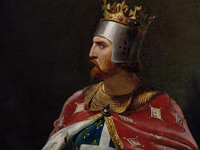
RESOURCES
This article uses material from the Wikipedia article "Richard I of England (1157-1199)", which is released under the Creative Commons Attribution-Share-Alike License 3.0.
© Stories Preschool. All Rights Reserved.
